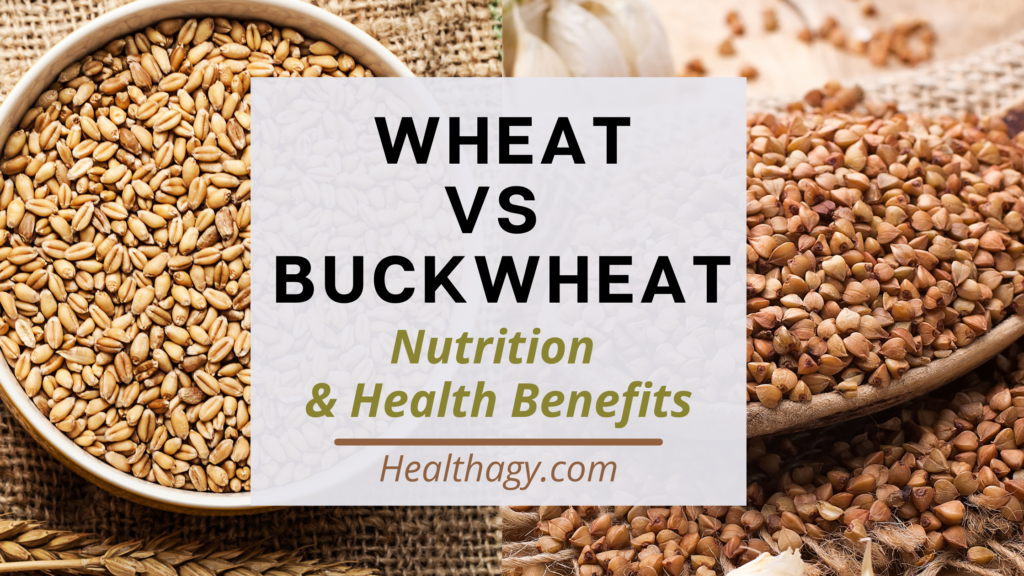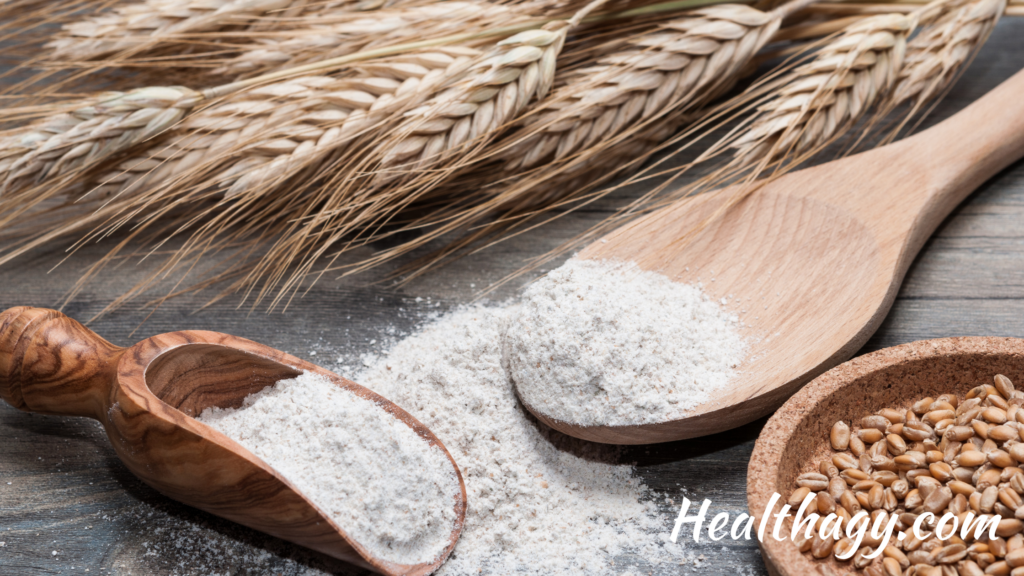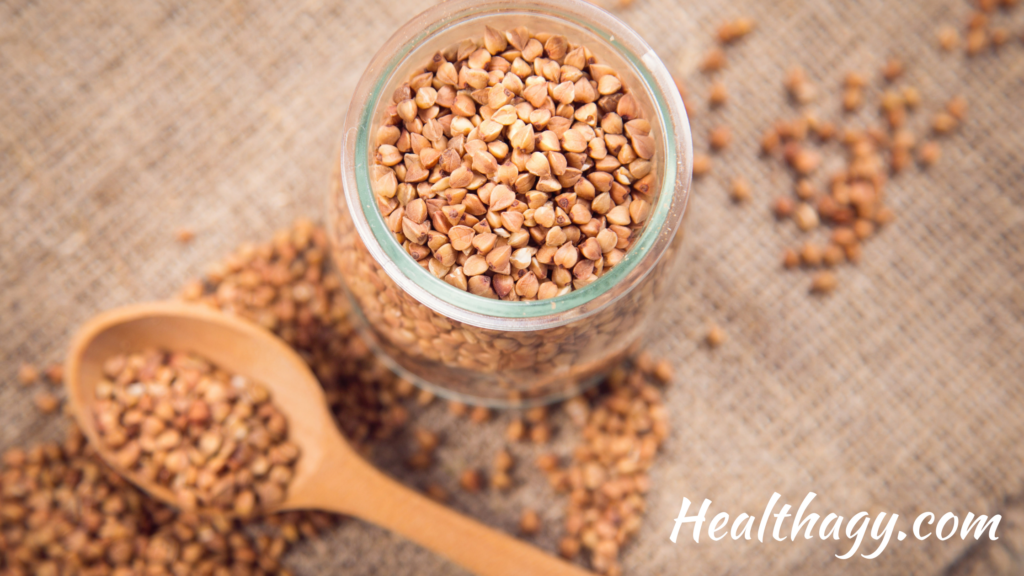
Wheat vs buckwheat, they sound so similar, but are they? Are they both whole grains? While they may have similar names and are both from seed-producing plants whose seeds are edible, they are, in fact, from two different plants.
They are nutritionally different and provide different health benefits. This begs the question, which is healthier? Can you substitute one for the other, and should you choose one over the other?
Key Differences Wheat vs Buckwheat
The main difference between wheat vs buckwheat is wheat is classified as a grass, while buckwheat is a seed. Nutritionally the main difference is wheat contains gluten, and buckwheat is gluten-free and safe for people with celiac disease or gluten intolerance. Buckwheat is considered to be a whole grain and nutritionally superior to wheat, offering many more health benefits.

What is Wheat?
Wheat belongs to the Poaceae family and is known as a grass. It is grown throughout the world and is one of the most popular cereal grains, along with rice and corn.
Wheat is commonly used in bread, crackers, pasta, cereals, among many other foods, particularly processed snack foods and baked goods.
There are two main wheat products: whole grain wheat and white wheat or refined wheat products. Whole grain wheat is used to make whole wheat flour and other whole wheat products, which contain the entire grain, the germ, endosperm, and bran. White wheat or refined wheat products are used to make white flour and white bread, removing the bran and the germ.
Wheat Taste
The flavor and texture of wheat will vary depending on what type of wheat it is made from and whether it is whole grain wheat or wheat that has been processed into refined white flour.
Some may describe wheat as slightly sweet, while some may consider it to have a bitter flavor. Whole grain wheat has a heartier and nuttier taste than refined white wheat, which has a more neutral and lighter flavor.
Nutritional Benefits and Health Consideration of Wheat
Like other grains, whole grain wheat has more nutritional benefits than its counterpart, refined white wheat. White flour is commonly fortified with nutrients that have been stripped away during the refining process.
Whole grain wheat contains the bran, germ, and endosperm of the wheat. It is an excellent source of fiber, which can promote regularity. It is also high in vitamin B, specifically vitamin B2, which helps support a healthy metabolism. It also contains varying amounts of other vitamins and minerals. Refined wheat, or the white wheat that is commonly used in baking and white bread, is stripped of the bran and germ, leaving only the endosperm. This process strips away the naturally occurring B-vitamins, iron and dietary fiber found in whole wheat products.
When it comes to wheat, there are a lot of opinions about whether it is healthy for you or not. One thing for sure is that if you eat a “standard American diet,” you are likely getting too much wheat in your diet. Wheat is also highly treated with pesticides which can contribute to a gluten intolerance for some people.
Many people have found that high consumption of wheat products, particularly refined wheat, has caused them to have digestive and gut issues or to develop a gluten intolerance which can lead to chronic inflammation and other health issues.
If you choose to consume wheat products, look for whole grain ones as they hold more nutritional value than refined wheat products and organic when possible, as wheat is often high in pesticides which can cause health implications.
Suppose you suspect you may have an intolerance to wheat or are experiencing chronic bloating, inflammation, or other gut-related issues. In that case, you may try eliminating wheat and gluten products from your diet for 30 days to see how your body responds.

What is Buckwheat?
Buckwheat is actually a fruit seed and not a true grain, although it is consumed like a grain and considered to be a grain, making it a pseudograin. Other pseudograins include wild rice, quinoa, and amaranth.
Buckwheat is not related to what at all as it is part of the Polygonaceae family. Buckwheat is the seed of the flowering plant Fagopyrum tataricum, which is related to rhubarb and sorrel. Buckwheat is gluten-free, making it a great alternative to wheat and wheat products for people with a gluten sensitivity.
Buckwheat is an ancient grain that dates back thousands of years. It has maintained its popularity in Asian and Eastern European countries throughout time. It lost its popularity in the United States with an increase in wheat and corn consumption. With people seeking a more balanced or gluten-free diet, buckwheat has become more common in American grocery stores again.
Buckwheat is also known for its flowers, which attract honey bees, aiding them to produce dark, antioxidant, and mineral-rich honey with a unique flavor, buckwheat honey.
Buckwheat Taste
Buckwheat seeds are commonly referred to as groats. Buckwheat groats are light-colored and mild in flavor. When cooked, they are soft and chewy, with a slightly bitter and nutty flavor. When roasted or toasted, they take on a more robust, more intense nutty flavor, known as “kasha.”

How to Eat Buckwheat
Buckwheat groats are the hulled seeds of the Buckwheat plant. The hulling process removes the outer husk leaving the seed inside that we know as buckwheat groats.
Buckwheat groats can be cooked like oatmeal, roasted or eaten raw. Raw buckwheat groats go great in granola mixes and provide texture, taste, and crunch when sprinkled on salads or yogurt. One of the most popular ways to eat buckwheat groats is as a breakfast porridge as an alternative to oatmeal. They can also be cooked like rice and eaten as a side dish for lunch or dinner.
Buckwheat can be ground into flour used in various buckwheat products, such as buckwheat pancakes, buckwheat noodles such as Japanese soba noodles, and buckwheat pasta.
Nutritional Benefits of Buckwheat
One of buckwheat’s many nutritional advantages over wheat is that it is a good source of plant protein. A one-half cup serving of raw buckwheat groats contains about ten to twelve grams of protein and is a complete protein containing all nine essential amino acids.
Like other grains, buckwheat is a great source of complex carbohydrates. It is a good source of fiber, which is excellent for digestive health and regularity, and can help manage weight and support weight loss by making you feel fuller and for longer. It is rich in antioxidants, minerals, and vitamins, making buckwheat a superfood! One cup of buckwheat cooked contains 4.5 grams of dietary fiber or 16% of the daily recommended value.
A few nutrients buckwheat groats are known for are a good source of folate, vitamin B6, magnesium, manganese, niacin, phosphorus, and zinc.
Health Benefits of Buckwheat
1. Blood Sugar Management
Buckwheat has a low glycemic index rating, providing a slower release of carbohydrates content into the bloodstream. This may help prevent spikes in glucose levels, help to manage blood sugar levels, improve insulin resistance, and control blood sugar issues and diabetes.
2. Supports Heart Health
Buckwheat has a phytonutrient and antioxidant called rutin. Rutin helps stabilize blood sugar and reduce cholesterol levels, which helps support cardiovascular health. The magnesium in buckwheat helps relax blood vessels and improve blood circulation. The copper, protein, and fiber help reduce the risk of heart disease by reducing inflammation, helping to lower high blood pressure, and preventing blood clots.
3. Gluten-Free
Many people find that a gluten-free diet or a balanced diet with a variety of whole grains while reducing their gluten intake help to best support their digestive and gut health while helping to lower inflammation levels and reduce bloating.
Key Takeaways
Buckwheat and wheat are two very different grains, with the main difference being that wheat has gluten and buckwheat is gluten-free.
Buckwheat is a great whole grain to add to your diet, whether you are gluten-free or not. Having a variety of nutrient-dense whole grains contributes to good overall health.
Read More About Buckwheat:
Karla Kueber is a Certified Evidence Based EFT Practioner and Health Coach, with a double Masters Degree in Education. She works with people to overcome emotional eating, curb cravings, and overcome resistance to eating new healthy foods. You can learn more about coaching with her here.